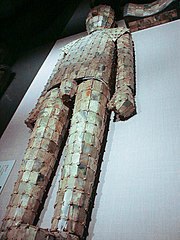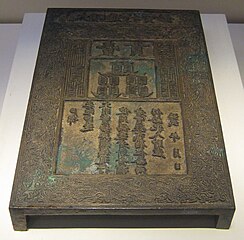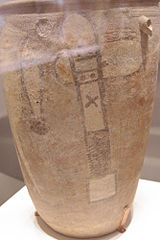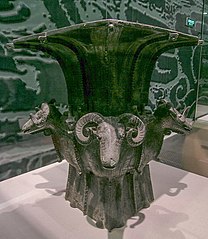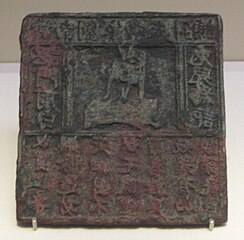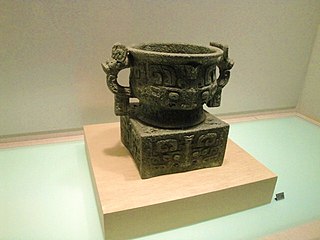Běijīng’s premier museum is housed in an immense 1950s Soviet-style building on the eastern side of Tiān’ānmén Sq, and claims to be the largest in the world by display space. You could easily spend a couple of hours in the outstanding Ancient China exhibition alone, with priceless artefacts displayed in modern, low-lit exhibition halls, including ceramics, calligraphy, jade and bronze pieces dating from prehistoric China through to the late Qing dynasty. You’ll need your passport to gain entry.
Treasure hunters should seek out the 2000-year-old jade burial suit in the basement exhibition, made for the Western Han dynasty king Liu Xiu, and the life-sized bronze acupuncture statue dating from the 15th century. A 2000-year-old rhino-shaped bronze zūn (wine vessel) is another stand-out treasure. The Ancient Chinese Money exhibition on the top floor, and the Bronze Art and Buddhist Sculpture galleries, one floor below, are also worth a browse.
The ground floor has a number of Salvador Dalí sculptures, and a room dedicated to socialist-realism art featuring the epic Birth of New China ink painting, depicting Mao Zedong addressing the nation to proclaim the establishment of the People’s Republic of China in 1949.
The museum, which is vast and energy-sapping, also has a ground-floor cafe (sandwiches from ¥20) and a teahouse.
The museum was established in 2003 by the merging of the two separate museums that had occupied the same building since 1959: the Museum of the Chinese Revolution in the northern wing (originating in the Office of the National Museum of the Revolution founded in 1950 to preserve the legacy of the 1949 revolution) and the National Museum of Chinese History in the southern wing (with origins in both the Beijing National History Museum, founded in 1949, and the Preliminary Office of the National History Museum, founded in 1912, tasked to safeguard China’s larger historical legacy).
The building was completed in 1959 as one of the Ten Great Buildings celebrating the ten-year anniversary of the founding of the People’s Republic of China. It complements the Great Hall of the People that was built at the same time. The structure sits on 6.5 hectares (16 acres) and has a frontal length of 313 metres (1,027 ft), a height of four stories totaling 40 metres (130 ft), and a width of 149 metres (489 ft).[4] The front displays ten square pillars at its center.
Front foyer with model of the Temple of Heaven. 
Collections
The museum, covering Chinese history from the Yuanmou Man of 1.7 million years ago to the end of the Qing Dynasty (the last imperial dynasty in Chinese history), has a permanent collection of 1,050,000 items, with many precious and rare artifacts not to be found in museums anywhere else in China or the rest of the world.
Among the most important items in the National Museum of China are the “Simuwu Ding” from the Shang Dynasty (the heaviest piece of ancient bronzeware in the world, at 832.84 kg),[8] the square shaped Shang Dynasty bronze zun decorated with four sheep heads,[8] a large and rare inscribed Western Zhou Dynasty bronze water pan,[8] a gold-inlaid Qin Dynasty bronze tally in the shape of a tiger,[8] Han Dynasty jade burial suits sewn with gold thread,[8] and a comprehensive collection of Tang Dynasty tri-colored glazed sancai and Song Dynasty ceramics.[8] The museum also has an important numismatic collection, including 15,000 coins donated by Luo Bozhao.[9]
The museum has a permanent exhibition called The Road to Rejuvenation, which details the glorious course of achieving national prosperity and fully reveals how the people chose Marxism, the Communist Party of China, socialism, and the reform policy. It attests to the Chinese priority of holding high the socialism and of remaining firmly committed to the Chinese socialist road and theory.
Gallery[edit]
-
A Han Dynasty jade burial suit laced with gold thread at the National Museum of China
-
A pastel pierced porcelain vase, from the Qianlong era of the Qing Dynasty
-
Copperplate for printing the Great Ming one string banknote
-
Bronze two-part pass (paizi) with a four character Tangut inscription inlaid in silver, from the Western Xia
-
A bronze vessel in the shape of a bat, from the tomb of Lady Fu Hao, from Shang Dynasty, 13th century BC
-
-
Painted stone relief depicting a warrior from the Later Liang Dynasty
-
-
Red lacquer box from the Qing Dynasty
-
Painted pottery of neolithic Yangshao culture, with depiction of a stork catching a fish and a stone axe on the side
-
Square zun with four sheep from late period of the Shang Dynasty
-
Bronze tallies with inscriptions inlaid in gold from the Warring States period, Chu State
-
Brick relief depicting two scholars and two maids, from the Southern Dynasties
-
Bronze plate for printing an advertisement for the Liu family needle shop at Jinan, Song Dynasty. The earliest extant example of a commercial advertisement
-
Bronze cannon with inscription dated the 3rd year of the Zhiyuan Era (1332), Yuan Dynasty
-
Large bronze basin of Guo Ji Zi Bai, from Western Zhou
-
Li gui, the earliest Zhou dynastybronze vessel to be discovered, and the only epigraphic evidence of the day of the Zhou conquest of Shang
-
Simuwu Ding, the largest piece of bronze work found in the world so far. It was made in the late Shang Dynasty at Anyang
-
A Song Dynasty copy of the Portraits of Periodical Offering of Liang, dated to the 6th century, depicting ambassadors from various tributary states
